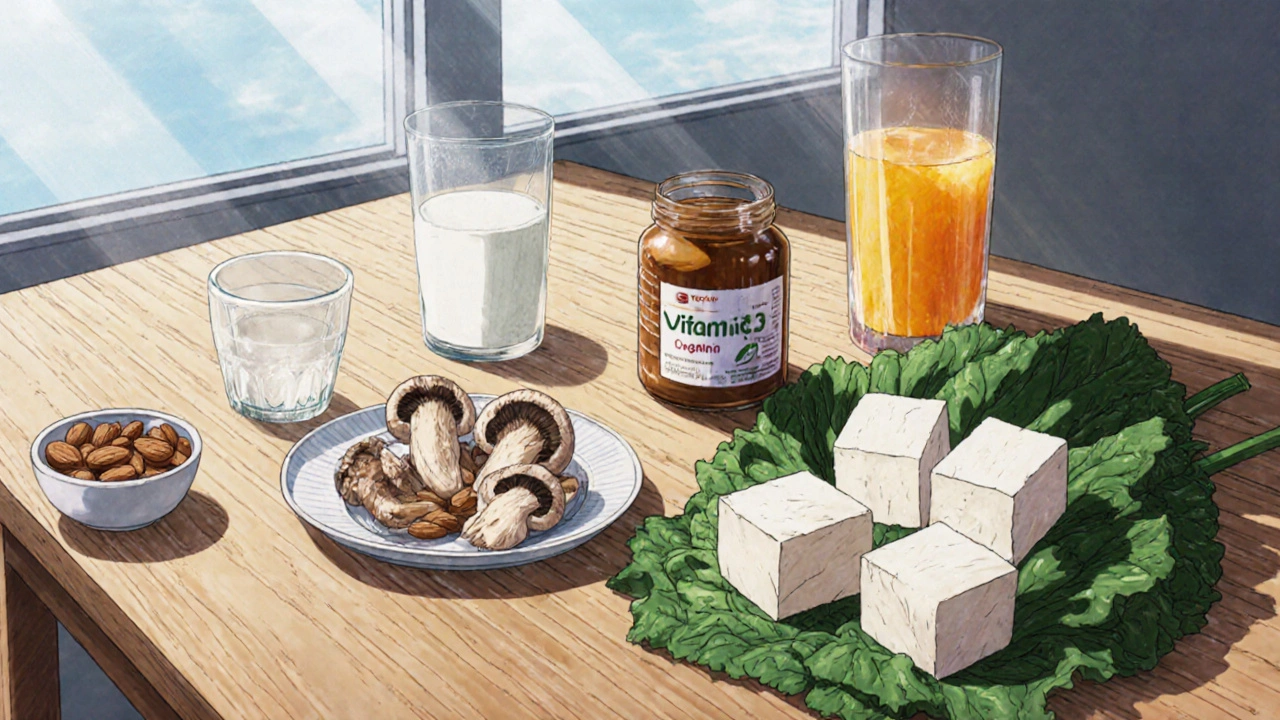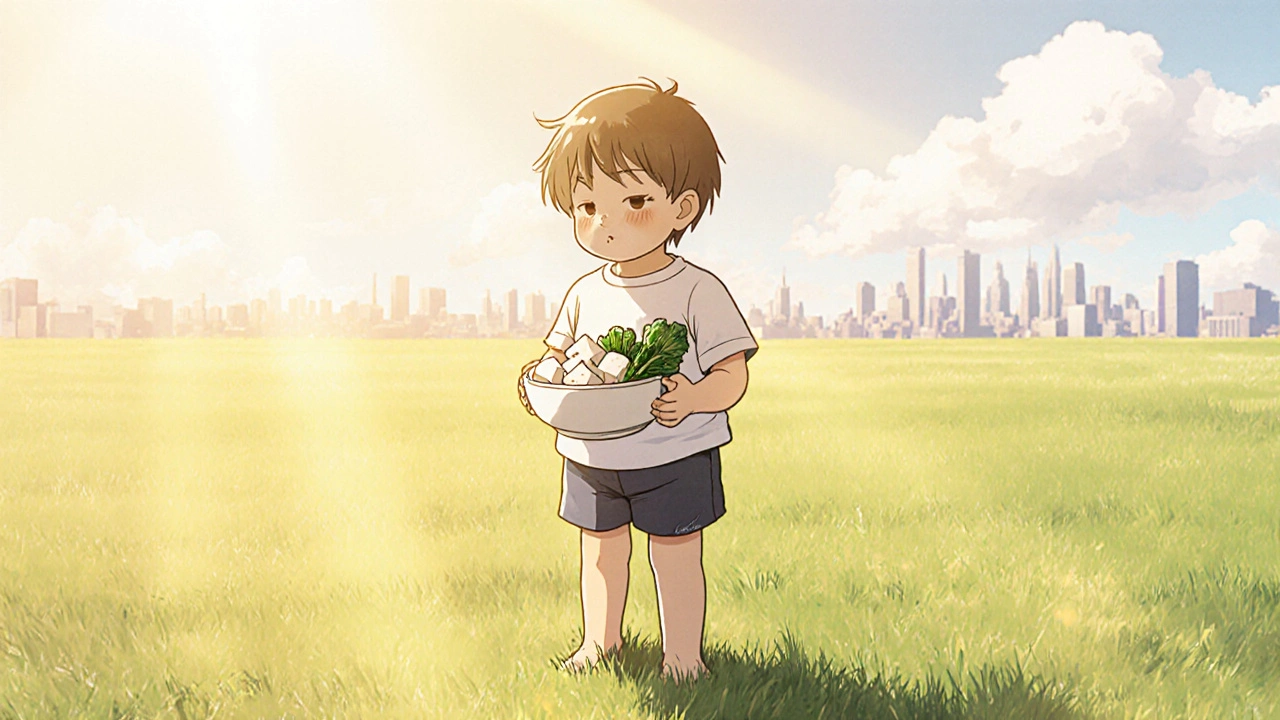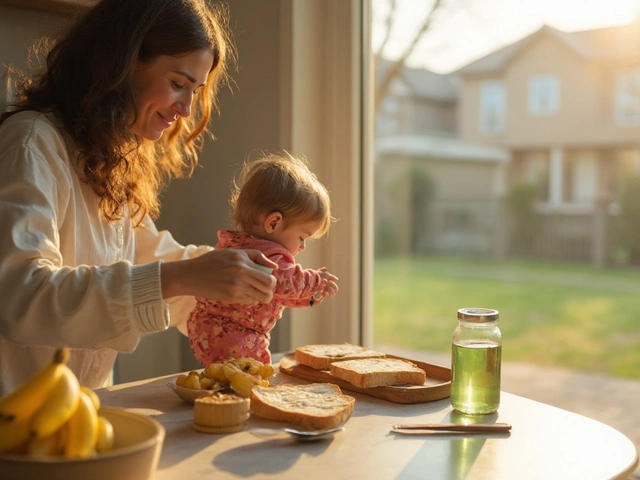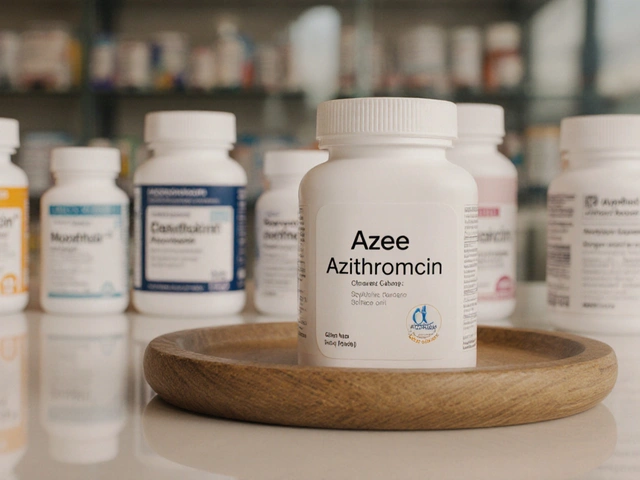Vegan Nutrient Calculator
Nutrient Calculator for Vegan Diets
This calculator helps you assess your vitamin D and calcium intake based on your age and diet. It's especially important for vegans to monitor these nutrients to prevent rickets and maintain bone health.
Thinking about going vegan or already following a plant‑based lifestyle? You might wonder if the choice could affect your bones, especially when it comes to rickets. The short answer: a well‑planned vegan diet can keep you healthy, but missing the right nutrients can raise the risk of rickets, especially for kids. This guide breaks down what rickets is, why vitamin D and calcium matter, and how vegans can stay bone‑strong.
What Is Rickets?
Rickets is a childhood bone disorder caused by impaired mineralization of the growing skeleton, leading to soft, weak bones and deformities such as bowed legs or thickened wrists. The condition usually stems from a shortage of vitamin D or calcium, or both. While rickets is rare in well‑nutrified populations, it remains a concern where diets lack these key nutrients.
Why Vegans Need to Pay Extra Attention
Traditional sources of vitamin D and calcium-like dairy, fish, and eggs-are absent in a strict vegan diet. That doesn’t mean vegans are doomed to rickets, but it does mean you have to be more intentional about where you get those nutrients.
- Vitamin D helps the gut absorb calcium and phosphate, the minerals that build bone.
- Calcium provides the structural framework for bone tissue.
- Both nutrients work together; low levels of one magnify the deficiency of the other.
When either vitamin D or calcium intake drops, the body cannot mineralize the growth plates in children, leading to rickets. Adults can develop a related condition called osteomalacia, which also weakens bones.
Key Risk Factors for Vegans
- Limited Sun Exposure: Vitamin D is synthesized when skin is exposed to UVB rays. Living in northern latitudes (like the UK) or spending most time indoors reduces natural production.
- Inadequate Fortified Foods: Not all plant milks or juices are fortified with vitamin D and calcium. Checking labels is essential.
- Poor Supplement Use: Some vegans avoid supplements, believing whole foods are enough. Unfortunately, getting enough vitamin D from food alone is challenging.
- Age: Babies, toddlers, and adolescents have the highest calcium and vitamin D needs because their bones are rapidly growing.

How to Get Enough Vitamin D on a Vegan Diet
Vegans have three main pathways to meet vitamin D requirements: sunlight, fortified foods, and supplements.
| Source | Typical Vitamin D Content (IU per serving) | Vegan? |
|---|---|---|
| Sunlight (15 min, face & arms) | ~1,000 IU | Yes |
| Fortified soy milk (1 cup) | 100‑150 IU | Yes |
| Fortified oat milk (1 cup) | 100‑150 IU | Yes |
| UV‑exposed mushrooms (½ cup) | 400‑600 IU | Yes |
| Cod liver oil (1 tsp) | 450 IU | No |
| Egg yolk (1 large) | 40 IU | No |
Because sunlight varies by season and skin tone, most vegans supplement. Look for vegan‑certified vitamin D3 (derived from lichen) or vitamin D2. Daily doses of 400-800 IU are typical for adults; children need age‑specific amounts (400 IU for infants, 600 IU for kids over 1 year).
How to Meet Calcium Needs Without Dairy
Calcium is abundant in many plant foods, but its bioavailability can differ. Here are reliable vegan sources:
- Fortified plant milks and juices: Often provide 300‑350 mg per cup, similar to cow’s milk.
- Tofu set with calcium sulfate: 250‑350 mg per ½ cup.
- Leafy greens such as kale, bok choy, and collard greens (150‑200 mg per cup cooked).
- Almonds: ~75 mg per ¼ cup.
- Sesame seeds and tahini: ~130 mg per tablespoon.
- Calcium‑rich beans like white beans (100 mg per half‑cup).
Aim for 1,000 mg/day for teenagers and 1,300 mg/day for adults. If you’re unsure you’re hitting the target, a vegan calcium supplement can fill the gap.
Putting It All Together: A Sample Day for a Vegan Child
- Breakfast: Fortified soy milk (300 mg calcium, 120 IU vitamin D) + whole‑grain cereal + sliced banana.
- Snack: Handful of almonds and a fortified orange juice.
- Lunch: Tofu stir‑fry with kale, broccoli, and sesame oil; serve over brown rice.
- Afternoon Snack: UV‑exposed mushroom slices on whole‑grain crackers.
- Dinner: Lentil soup with collard greens; side of fortified oat milk.
- Supplements: Vegan vitamin D3 (400 IU) taken with breakfast.
This plan supplies roughly 1,150mg calcium and 500IU vitamin D, comfortably meeting the recommended intakes for a growing child.

Common Pitfalls and How to Avoid Them
- Relying on ‘natural’ foods alone: Even the best plant foods can fall short without fortified options.
- Skipping supplements in winter: Sunlight in the UK is weak from October to March; supplement during those months.
- Ignoring label details: Not all fortified products contain vitamin D; verify the amount per serving.
- Assuming calcium absorption is the same: Oxalates in spinach bind calcium; choose low‑oxalate greens like kale.
When to Seek Professional Advice
If you notice any of these signs in a child-delayed growth, bowed legs, dental issues, or bone pain-consult a healthcare professional. Blood tests for 25‑hydroxy vitamin D and serum calcium can pinpoint deficiencies. A dietitian familiar with vegan nutrition can craft a tailored plan.
Frequently Asked Questions
Can a vegan adult develop rickets?
Yes, though it’s rare. Adults can develop osteomalacia, a condition similar to rickets, if they consistently lack vitamin D and calcium. Adequate supplementation and fortified foods usually prevent this.
Is vitamin D2 as effective as D3 for vegans?
Vitamin D3 (from lichen) is generally more potent and raises blood levels faster than D2. However, high‑dose D2 can still be effective if taken consistently.
What amount of sunlight is needed to produce enough vitamin D?
Around 10‑15 minutes of midday sun on arms and face for light‑skinned individuals, longer for darker skin tones or higher latitudes. In the UK during winter, sunlight isn’t enough, so supplementation is recommended.
Are fortified plant milks reliable sources of calcium?
Most fortified soy, oat, and almond milks provide 300‑350mg calcium per cup, comparable to dairy milk. Always check the label for calcium carbonate or calcium phosphate as the fortifying agent.
How often should a vegan child be screened for vitamin D deficiency?
Annual blood tests are a good practice, especially for children under five, those with limited sun exposure, or those with dietary restrictions that may affect nutrient intake.






Mary Davies
October 17, 2025 AT 15:09I was instantly drawn in by the way the article paints the picture of vegan kids navigating the delicate dance of calcium and sunlight. It feels like a quiet alarm ringing in the background, reminding us that health is a balance of intention and knowledge. The drama of bowed legs and fragile bones is presented without fear, just a solemn call to vigilance. Even the most casual reader can sense the weight behind the statistics.
Valerie Vanderghote
October 17, 2025 AT 16:49Reading through the guide reminded me of that moments when I first tried to figure out my own diet, the endless scroll of ingredient lists and the constant worry about missing some invisible nutrient that could topple my whole health regimen. I found myself scrolling back and forth, checking the fortified labels on soy milks, the tiny print about vitamin D2 versus D3, the haunting thought that a single cup could be the difference between a strong skeleton and a future of bone pain; it was exhausting and yet exhilarating, as if each label held a secret map to a treasure I was desperate to locate. The author’s thorough breakdown of sunlight exposure felt like a warm sunrise breaking through a fog of misinformation, and the practical sample day for a child read like a carefully choreographed ballet where each ingredient steps in perfect time with the next. I could almost taste the tofu stir‑fry, see the glowing mushrooms, and feel the reassurance of the supplement tucked in with breakfast, all while the clock ticked on a winter morning in the UK, where the sun is a shy guest. It’s a vivid reminder that veganism isn’t a passive choice but an active, daily commitment to learning, adjusting, and thriving, and that the journey, though sometimes daunting, is lined with opportunities to be creative, nourishing, and resilient.
Michael Dalrymple
October 17, 2025 AT 18:29The article does an excellent job of translating complex nutritional science into actionable steps that any caregiver can follow. By emphasizing both diet and supplementation, it provides a balanced roadmap that respects the ethical choices of vegans while safeguarding bone health. The clear presentation of calcium‑rich foods alongside fortified options creates a comprehensive strategy that is both realistic and reassuring.
Emily (Emma) Majerus
October 17, 2025 AT 20:09Thx for the tip on fortified oat milk its a game changer for calcium intake.
Virginia Dominguez Gonzales
October 17, 2025 AT 21:49Seeing the rundown of common pitfalls felt like watching a drama unfold where the villain is ignorance and the hero is informed choice. The warning about oxalates in spinach, for example, crackles with the tension of a plot twist that could spoil a well‑planned meal. Yet the article offers a bright, hopeful finale: with a few mindful swaps, vegan families can build bones as strong as oak. It’s a rallying cry to stay vigilant, stay fortified, and keep those little legs standing tall.
Alexis Howard
October 17, 2025 AT 23:29Sure vegans can avoid rickets but you gotta watch your D and calcium intake
Darryl Gates
October 18, 2025 AT 01:09Indeed, the recommendation to aim for 1,000 mg of calcium per day for teenagers aligns with the Institute of Medicine’s Dietary Reference Intakes. Fortified plant milks typically contain calcium carbonate, which boasts a bioavailability comparable to dairy sources. Additionally, pairing calcium‑rich foods with vitamin D‑rich meals enhances absorption, a synergy highlighted in the guide. Consistent monitoring through annual blood tests ensures deficiencies are caught early, allowing for timely dietary adjustments.
Kevin Adams
October 18, 2025 AT 02:49When I first laid eyes on the table of vitamin D sources, I felt as if I had opened a portal to an ancient alchemical laboratory where sunlight, mushrooms, and lichen conspired to forge the very essence of bone. The notion that a humble cup of soy milk could whisper 120 IU of vitamin D into the bloodstream is nothing short of poetic, a quiet miracle tucked within a daily ritual. Yet the narrative does not rest on miracles alone; it calls upon us to become architects of our own skeletal destiny, to mix and match fortified juices, UV‑exposed fungi, and precisely measured supplements as if we were composing a symphony of minerals. The sample day for a vegan child reads like a storybook, each meal a chapter that builds strength and resilience against the looming specter of rickets. One imagines the child’s laughter echoing through a kitchen where tofu is diced with the same reverence once reserved for sacred herbs. The emphasis on low‑oxalate greens, such as kale, stands as a strategic move in a chess game where calcium is the prized queen, continually threatened by the pawn of oxalates. I am struck by the way the guide acknowledges the harsh winter months of the United Kingdom, where the sun hides its face and supplements become the lone torchbearers of vitamin D. This seasonal awareness feels like a reminder that health is not static but a fluid dance with the environment, each step requiring adaptation. The discussion of lichen‑derived D3 versus D2 unfurls a debate that could rival any philosophical treatise on potency and purity. It is a reminder that not all sources are created equal, and that the careful selection of a vegan‑certified D3 can lift blood levels with a grace that D2 struggles to match. The article also shines a light on the importance of label scrutiny-a seemingly mundane task that, in reality, serves as a gatekeeper to nutritional adequacy. In a world where manufacturers may slip in sub‑therapeutic fortification levels, the vigilant consumer becomes a guardian of their own health. The call to annual blood testing for children under five reads not as a bureaucratic imposition but as a compassionate invitation to catch deficiencies before they manifest as bowed limbs. The tone balances urgency with empowerment, never instilling fear but fostering a proactive mindset. Ultimately, this guide stands as a beacon, illuminating the path for vegans to nurture bones that are as robust as the convictions that guide their dietary choices.
Katie Henry
October 18, 2025 AT 04:29Let us celebrate the commitment to a compassionate diet while steadfastly protecting our children’s skeletal health; the strategies outlined herein empower us to do both with confidence and grace.
Nickolas Mark Ewald
October 18, 2025 AT 06:09Great info thanks for sharing the practical tips.
Chris Beck
October 18, 2025 AT 07:49Brits have better bone health because we get more sunshine and less processed junk.
Winston Bar
October 18, 2025 AT 09:29Honestly this article reads like a sales pitch for overpriced fortified milks, not a real solution for everyday families.
Russell Abelido
October 18, 2025 AT 11:09I feel the weight of those worried parents, the silent fear of seeing a child struggle with pain; know that you’re not alone, community can lift you up 😊 keep pushing forward with the right nutrients and love.
Patricia Echegaray
October 18, 2025 AT 12:49What they won’t tell you is that big dairy corporations secretly fund the “vitamin D deficiency” scare to keep us dependent on their fortified products, pulling the strings behind the scenes to protect their profit empire.